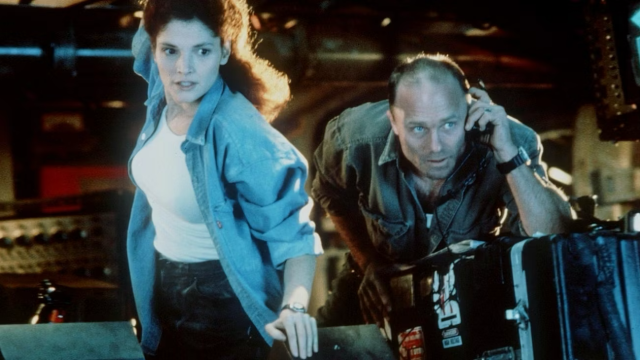AUTHOR’S NOTE: For the sake of this column, I will only be reviewing the Director’s Cut
James Cameron is the undisputed biggest filmmaker in the world. As of this writing, he has made three of the four highest-grossing movies of all-time. Commercially, it has become clear that he can do no wrong. But as he’s become more and more financially (if not critically) successful, it feels worthwhile to look back at the last movie he made that didn’t gross over $100 million, his 1989 canonical dad movie, The Abyss.
The Abyss, from its deep-sea setting to its themes of man’s conflict with nature, feels like the most James Cameron movie ever made. However, what’s gone mostly unremarked about his style is how neatly his films slot in to the dad movie genre, while maintaining their own personal identities. Aliens turned the sci-fi horror film into a war movie; Terminator 2: Judgment Day mixed high-octane action with what is, at heart, a father-son bonding adventure; even Titanic, which has for years been filed (wrongly) under the heading of “chick flick” has a preoccupation with historical detail common to a lot of dad movies.
The movie focuses on an underwater drilling team, lead by the separated husband-and-wife team of Virgil “Bud” Bridgman (Ed Harris) and Lindsey Brigman (Mary Elizabeth Mastrantonio), and their efforts to salvage a nuclear submarine against a backdrop of saber-rattling between the United States and the Soviet Union. For the first hour of the movie, this plotline takes precedence and Cameron delights in ratcheting up the tension through a painstaking emphasis on process. Dad movies tend to relish showing how people who are good at their jobs approach their work, and The Abyss is no exception. In a move that’s both incredibly cheesy and undeniably brilliant, Cameron has the crew engage in a sing-along of Little Feat’s trucker anthem “Willin.’” Their work may seem scientific, but at heart, these are blue collar workers trying to finish a difficult job.
Of course, as the movie goes on, it reveals itself to be closer in spirit to something like Close Encounters of the Third Kind or Contact. The mystery of what sank the sub reveals itself to be a “non-terrestrial intelligence,” or NTI in the movie’s parlance. The focus of the movie shifts from attempting to clean up the nuclear wreckage to trying to make contact with an alien intelligence that may or may not be hostile. In its broad strokes, The Abyss borrows much of its plot from a personal favorite of mine (and the first in a long-running series of dad movies) Star Trek: The Motion Picture, from an opening attack by an alien force that threatens to turn up the heat on a cold war, to a climactic special effects-fueled journey through an alien civilization. The relationship between the Brigmans feels like it owes as much to the Kirk-Spock rapport as it does to the relationship between Cameron and his producer (and then-wife) Gail Anne Hurd. Even the design of the NTIs feels influenced by Douglas Trumbull’s celebrated effects from Star Trek: The Motion Picture.
Unlike that movie, which has been widely derided as boring (even fans call it “The Motionless Picture” or “The Slow-Motion Picture”), The Abyss remains endlessly thrilling even as it pushes the three-hour mark. Like Spielberg, Cameron is able to makes large-scale entertainment without losing his personality in it. It’s easy to make fun of movies like Titanic and the Avatar movies, but when push comes to shove, just about everyone still ends up getting sucked into their narratives. In what still feels like his most personal movie to date, Cameron was able to start with the incredible dad movie premise of a deep-sea thriller and turn it into a meditation on man’s capacity for cruelty and love.
UP NEXT: For the first series to be covered in its entirety in this column, we look at the current state of the dad movie through the lens of the John Wick movies.


